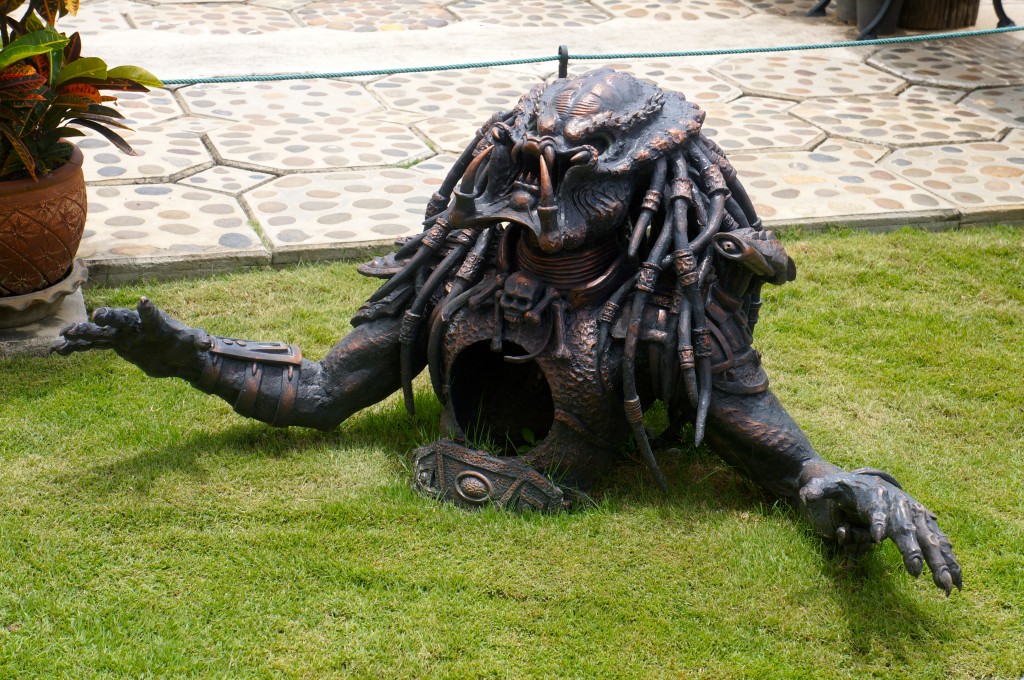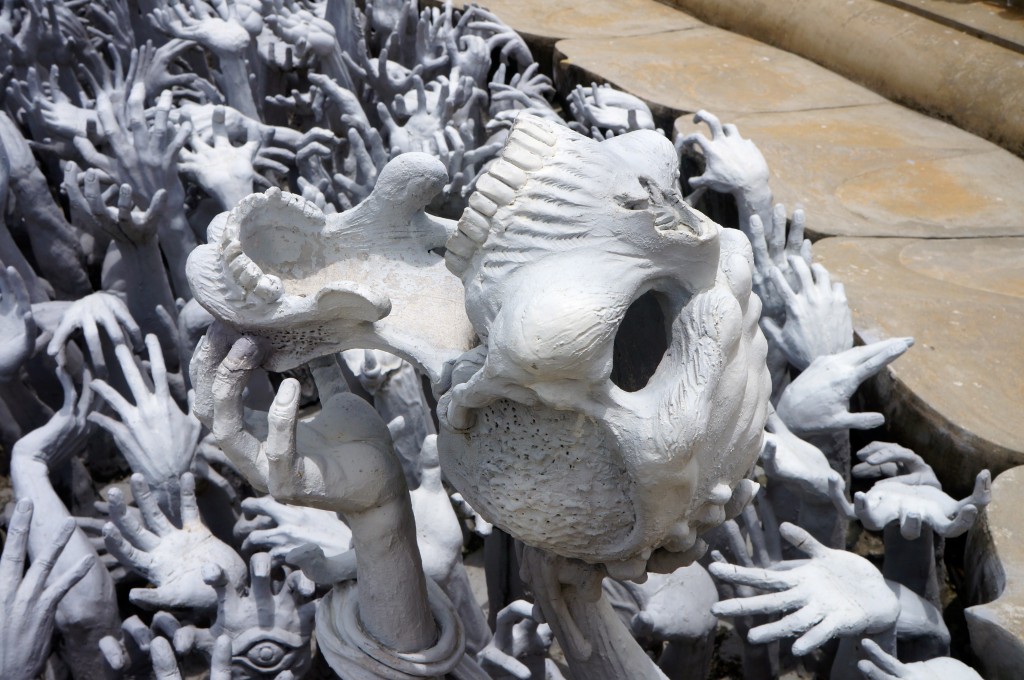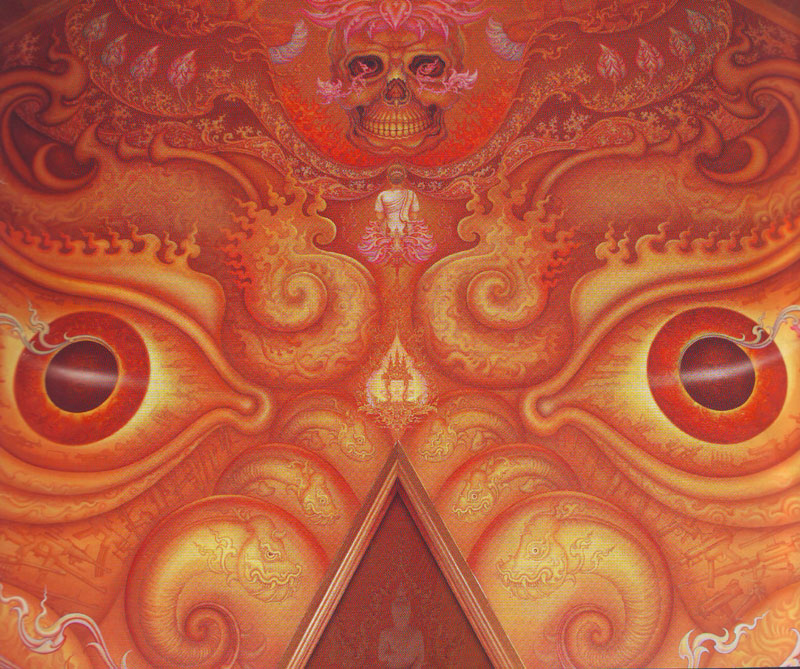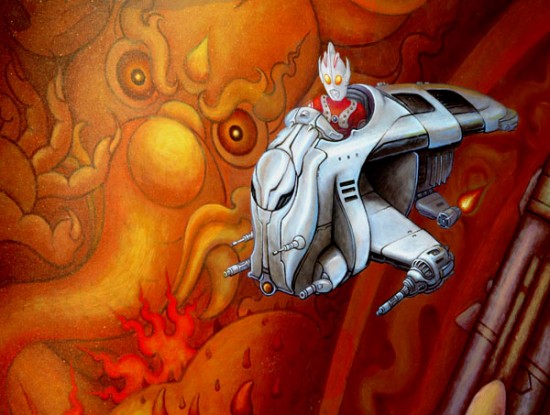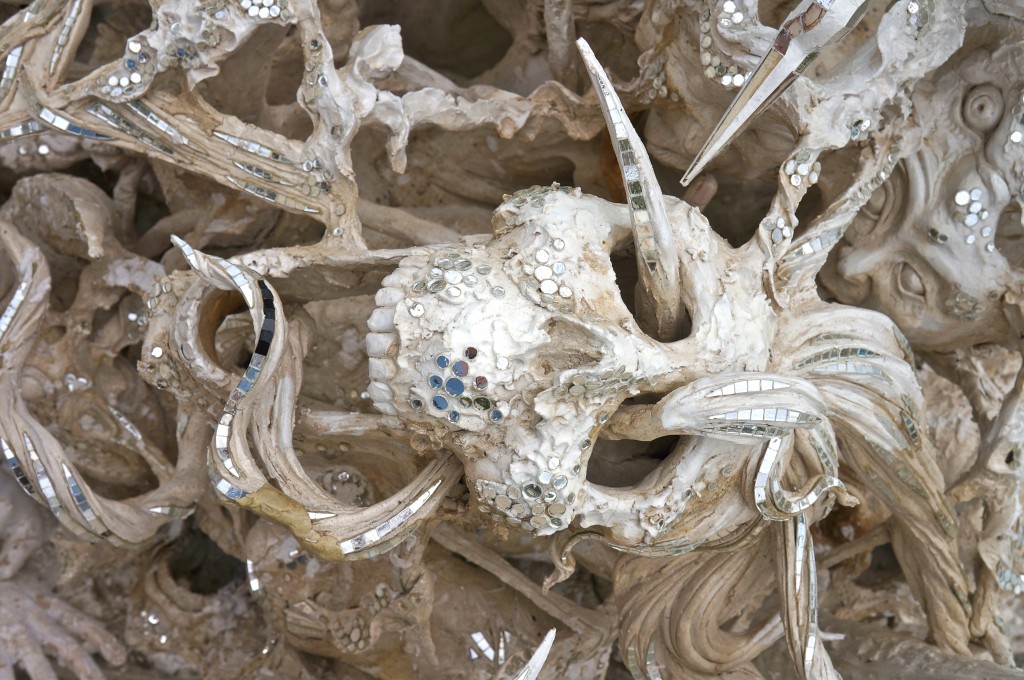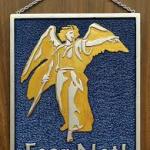About 13 km south of Chiang Rai in northern Thailand, you can visit Wat Rong Khun, aka the White Temple. It is one of the most striking religious sites in the country and possibly the world. Here the sacred and the secular meet in mind-boggling fashion.
Grab a local bus in the center of Chiang Rai and for about $0.60 you can be there in 20-30 minutes depending on how full the bus is and how fast the driver is going. Dropped off at a major intersection, it’s a 2-3 minute walk to the unmistakable Wat.
Visiting on a cloudy day, the brilliant white and mirrored exterior stood in stark contrast to the dark gray skies. The first thing you notice is the absence of color, which so beautifully decorates other temples throughout the country. The next are the grounds on which the temple complex sits, which are immaculately kept and clean. By this time, you’ve no doubt come across some of the more startling artwork and decorations from the skull topped traffic cones (just the first of many skulls to remind you of your mortality) to a half-buried Predator statue. An attendee at the gate checks to see if you’re properly attired (knees and shoulders covered please) before you enter the complex. As you make your way around to the bridge into the Wat itself there are numerous sculptures and fountains in the surrounding moat that range from the traditional dancing ladies to anthropomorphic dragons. Surrounding the entrance to the bridge are two pools out of which hundreds of sculpted arms and hands reach. These are in various poses and cover the human to the demonic to the super-heroic (a Wolverine knockoff anyone?). The bridge entrance is also guarded by what appear to be two hags and two warriors.
The exterior of the Wat is constructed in traditional fashion and is completely white to reflect the purity of the Buddha. The inside is a completely different matter. Three of the four walls have been painted by artist Chalermchai Kositpipat, who is also designing the entire complex, which isn’t scheduled to be completed until 2070 (Buddha willing I’ll live that long to see it’s completed form). The front wall features a typical image of the Buddha but the left and back walls are a completely different matter. The back wall features an image of the Buddha seated atop a skull. Below that is the face of a large demon and sprawling below it…well it’s almost unbelievable. It’s like the love child of Buddhism and Entertainment Weekly. In one of the demon’s pupils is an image of George W. Bush and in the other Bin Laden. Swirling out to the left and right are streams of semi-automatic weapons. Below this extends what can only be described as a post-apocalyptic nightmare populated by some of the most popular pop-culture figures of the twenty and twenty-first centuries. Working from left to right are, to name a few, the Incredible Hulk, Darth Vader, Keanu Reeves as Neo from The Matrix, a Transformer, characters from Avatar, Kung Fu Panda, the clown from the Saw series, Freddy Kruger, Spider-Man, Ben 10, Jack Sparrow, and Harry Potter. Between the middle and right door (looking outside) is a scene of the 9/11 attacks. As you look more closely and move your gaze right, you notice images of individuals seated on lotus leafs drifting to the right and away from all this chaos. As you follow the “passengers” you realize they are being drawn to the image of the Buddha, seated in peaceful repose.
My wife Amy actually pointed this out to me. I was wrapped in reflection on the tension between the sacred and the profane and how the former was being secularized and the latter sacralized…you know…all that really academic religious discourse. I certainly think it applies here because it’s a surreal experience to be looking at a painting of Jack Sparrow while devout Buddhists are knelt in prayer behind you. But Amy pointed out how the individuals in the lotus leaves were being led away from all the political and pop cultural chaos to something more peaceful, life-giving and sacred. I think there’s much to this given the contrasting serenity and discord between the two murals. Kositpipat has taken some flak for such visual juxtapositions, but it’s a welcome and intriguing addition to the consistent, traditional religious images we’ve been encountering over the past couple of months.
The rest of the complex is rather tame by comparison as some of it, including the final wall in the temple, is still under construction. However, another bridge and sculpture behind the temple itself provides a beautiful view. There’s a wishing well and a couple of tall stands that display devotees’ key chain-like prayers. You can exit through the requisite gift shop where there are replicas of Kositpipat’s sacred work but surprisingly few feature his work with secular content. There are a handful of publications, but few in English. Before you leave the area, be absolutely sure to visit the museum dedicated to Kositpipat, which features an extensive collection of his original work that covers the religious, political and cultural spectrum. There are drawings and sketches of places in the United States that he made on a recent visit from New Orleans to New York. There’s even a painting of Bush and Bin Laden riding a spaceship cowboy style in outer space.
The White Temple should be an art and religion lovers’ pilgrimage, especially if you’re in Thailand. The kitschy juxtaposition of the ridiculous and the sublime…of the new and traditional…make it a viewing (and perhaps devotional) experience unlike any other.


